Plain Stilling Basin Performance below 30° and 50° Inclined Smooth and Stepped Chutes
Abstract
1. Introduction
2. Materials and Methods
2.1. Physical Model
2.2. Instrumentation
3. Test Program and Inflow Conditions
4. Results and Discussion
4.1. Free Surface Characteristics
4.1.1. Mean Flow Depths
4.1.2. Roller Length
4.1.3. Flow Depth Fluctuations and Jump Length
4.2. Bottom Pressure Characteristics
4.2.1. Streamwise Pressure Distribution and Jump Length
4.2.2. Streamwise Distribution of Mean Pressure
- deflection zone along 0 ≤ XJ ≤ 0.18, characterized by increased mean pressures due to the impact and flow curvature
- transition zone along 0.18 < XJ < 1, where mean pressures qualitatively follow the flow depths, and
- tailwater zone along XJ ≥ 1, where mean pressures are quasi-hydrostatic.
4.2.3. Streamwise Distribution of the Pressure Fluctuation
4.2.4. Streamwise Distribution of Extreme Pressures
4.2.5. Streamwise Distribution of Bottom Air Concentration and Cavitation Damage Protection
5. Conclusions
- The use of equivalent clear water parameters at the chute end leads to a fairly accurate prediction of the sequent depth ratio using classical momentum principle, irrespective of the approach flow conditions or chute slope φ, for a given approach Froude number F1.
- The free surface characteristics along the plain stilling basin, such as dimensionless flow depths Z and dimensionless flow depth fluctuations CH’, are independent of the approach flow conditions or chute slope φ, either for smooth or stepped chutes.
- The dimensionless roller lengths LR/h2 are independent of the approach flow conditions or chute slope φ.
- The dimensionless hydraulic jump lengths LR/h2 are practically independent of the chute slope φ. Further, the results support the conclusions made by [5], stating that hydraulic jumps initiated below stepped chutes require an increased length x/h2 as compared to those below smooth chutes.
- It is recommended that longer dimensionless plain stilling basin lengths are provided below stepped chutes irrespective of the chute slope, namely LJ ≈ 6.7h2 as compared to LJ ≈ 5.8h2 below smooth chutes, plus a safety margin.
- Increasing chute slope pronounces dimensionless mean bottom pressures Pm, due to the stronger flow curvature, and slightly extends the influence reach of the flow curvature. The latter is more significant for stepped chute inflows.
- Fluctuation and extreme pressure coefficients along the plain stilling basin invert are independent of the approach flow aeration C1 or chute slope φ below smooth chutes.
- Stepped chute inflows increase the fluctuating and extreme pressure coefficients at the plain stilling basin entrance, as compared to smooth chute inflows. Increasing stepped chute slope increases the extreme and fluctuating pressure coefficients within XJ ≤ 0.13. For 50° stepped chutes, these coefficients can reach up to 3 times higher magnitudes compared to smooth chute inflows or up to 2 times higher compared to the 30° stepped chute inflows.
- The bottom air concentration development along the plain stilling basin below smooth chutes is independent of the chute slope φ, for XJ ≥ 0.08. Stepped chute inflows increase bottom air concentration within XJ ≤ 0.4. Increasing stepped chute slope slightly increases the bottom air concentration within the latter region, namely by some 2% for 50° stepped chute compared to 30° chutes.
- The cavitation protection length is independent of the chute slope, namely for: (1) smooth chute inflows within 0.1 ≤ XJ ≤ 0.5 and 0.15 ≤ XJ ≤ 0.4 considering 5% and 8% bottom air concentration limit, and (2) stepped chute inflows within 0 ≤ XJ ≤ 0.5 and 0 ≤ XJ ≤ 0.4 considering 5% and 8% bottom air concentration limit. Evidently, stepped chute approach flows provide better cavitation damage protection in the initial reach of the plain stilling basin.
- The increased extreme pressures below stepped chutes within XJ ≤ 0.13 are not expected to represent a danger in terms of cavitation. In spite of this, the increased bottom pressure coefficients below stepped chutes should be considered in the plain stilling basin slab design.
Author Contributions
Funding
Institutional Review Board Statement
Informed Consent Statement
Data Availability Statement
Conflicts of Interest
References
- Chanson, H. Hydraulics of Stepped Chutes and Spillways; August Aimé Balkema: Rotterdam, The Netherlands, 2002. [Google Scholar]
- Chanson, H.; Bung, D.B.; Matos, J. Stepped spillways and cascades. In Energy Dissipation in Hydraulic Structures; CRC Press: Leiden, The Netherlands, 2015; pp. 45–64. [Google Scholar]
- Hager, W.H.; Schleiss, A.J.; Boes, R.M.; Pfister, M. Stepped chute. In Hydraulic Engineering of Dams; CRC Press: Leiden, The Netherlands, 2021; pp. 277–319. [Google Scholar]
- Frizell, K.W.; Frizell, K.H. Guidelines for Hydraulic Design of Stepped Spillways; Hydraulic Laboratory Report HL-2015-06; U.S. Bureau of Reclamation: Denver, CO, USA, 2015.
- Stojnic, I.; Pfister, M.; Matos, J.; Schleiss, A.J. Effect of 30-Degree Sloping Smooth and Stepped Chute Approach Flow on the Performance of a Classical Stilling Basin. J. Hydraul. Eng. 2021, 147, 04020097. [Google Scholar] [CrossRef]
- Bung, D.B.; Sun, Q.; Meireles, I.; Viseu, T.; Matos, J.S. USBR type III stilling basin performance for steep stepped spillways. In Proceedings of the 4th International. IAHR Symposium on Hydraulic Structures, Porto, Portugal, 9–11 February 2012. [Google Scholar]
- Frizell, K.W.; Svoboda, C.D. Performance of Type III Stilling Basins–Stepped Spillway Studies; U.S. Bureau of Reclamation: Denver, CO, USA, 2012.
- Frizell, K.W.; Svoboda, C.D.; Matos, J. Performance of type III stilling basins for stepped spillways. In Proceedings of the 2nd International Seminar on Dam Protection Against Overtopping, Fort Collins, CO, USA, 7–9 September 2016. [Google Scholar]
- Meireles, I.; Matos, J.; Silva Afonso, A. Flow characteristics along a USBR type III stilling basin downstream of steep stepped spillways. In Proceedings of the 3rd International Junior Researcher and Engineer Workshop on Hydraulic Structures, Brisbane, Australia, 2–4 May 2010. [Google Scholar]
- Novakoski, C.K.; Conterato, E.; Marques, M.; Teixeira, E.D.; Lima, G.A.; Mees, A. Macro-turbulent characteristics of pressures in hydraulic jump formed downstream of a stepped spillway. RBRH 2017, 22. [Google Scholar] [CrossRef]
- Novakoski, C.K.; Hampe, R.F.; Conterato, E.; Marques, M.G.; Teixeira, E.D. Longitudinal distribution of extreme pressures in a hydraulic jump downstream of a stepped spillway. RBRH 2017, 22. [Google Scholar] [CrossRef][Green Version]
- Stojnic, I.; Pfister, M.; Matos, J.; Schleiss, A.J. Air-water flow in a plain stilling basin below smooth and stepped chutes. J. Hydraul. Res. 2022. [Google Scholar] [CrossRef]
- Schwalt, M.; Hager, W.H. Die Strahlbox. Schweiz. Ing. Archit. 1992, 110, 547–549. (In German) [Google Scholar] [CrossRef]
- Stojnic, I. Stilling basin performance downstream of stepped chutes. Ph.D. Thesis, École Polytechnique Fédérale de Lausanne, Lausanne, Switzerland, 2020. [Google Scholar]
- Wood, I. Uniform region of self-aerated flow. J. Hydraul. Eng. 1983, 109, 447–461. [Google Scholar] [CrossRef]
- Wood, I. Air entrainment in free-surface flows. In IAHR Hydraulic Structures Design Manuals 4: Hydraulic Design Considerations, 1st ed.; Wood, I., Ed.; CRC Press/Balkema: Rotterdam, The Netherlands, 1991; pp. 1–152. [Google Scholar]
- Chanson, H.; Toombes, L. Air–water flows down stepped chutes: Turbulence and flow structure observations. Int. J. Multiph. Flow 2002, 28, 1737–1761. [Google Scholar] [CrossRef]
- Takahashi, M.; Ohtsu, I. Aerated flow characteristics of skimming flow over stepped chutes. J. Hydraul. Res. 2012, 50, 427–434. [Google Scholar] [CrossRef]
- Matos, J.; Meireles, I. Hydraulics of stepped weirs and dams spillways: Engineering challenges, labyrinths of research. In Proceedings of the 5th IAHR International Symposium on Hydraulic Structures (ISHS 2014), Brisbane, Australia, 25–27 June 2014. [Google Scholar]
- Peterka, A.J. Hydraulic Design of Stilling Basins and Energy Dissipators; U.S. Department of the Interior: Denver, CO, USA, 2008.
- Fiorotto, V.; Rinaldo, A. Turbulent pressure fluctuations under hydraulic jumps. J. Hydraul. Res. 1992, 30, 499–520. [Google Scholar] [CrossRef]
- Lopardo, R.A.; De Lio, J.C.; Vernet, G.F. Physical modelling on cavitation tendency for macroturbulence of hydraulic jump. In Proceedings of the International Conference on the Hydraulic Modelling of Civil Engineering Structure, Conventry, UK, 22–24 September 1982. [Google Scholar]
- Toso, J.W.; Bowers, C.E. Extreme Pressures in Hydraulic-Jump Stilling Basins. J. Hydraul. Eng. 1988, 114, 829–843. [Google Scholar] [CrossRef]
- Peterka, A.J. The effect of entrained air on cavitation pitting. In Proceedings: Minnesota International Hydraulic Convention, Proceedings of the 1953 Minnesota International Hydraulics Convention, Minneapolis, MN, USA, 1–4 September 1953; American Society of Civil Engineers: New York, NY, USA, 1953. [Google Scholar]
- Rasmussen, R.E.H. Some experiments on cavitation erosion in water mixed with air. In Proceedings International Symposium on Cavitation in Hydrodynamics; National Physical Laboratory: London, UK, 1956. [Google Scholar]
- Russell, S.O.; Sheehan, G.J. Effect of entrained air on cavitation damage. Can. J. Civ. Eng. 1974, 1, 97–107. [Google Scholar] [CrossRef]
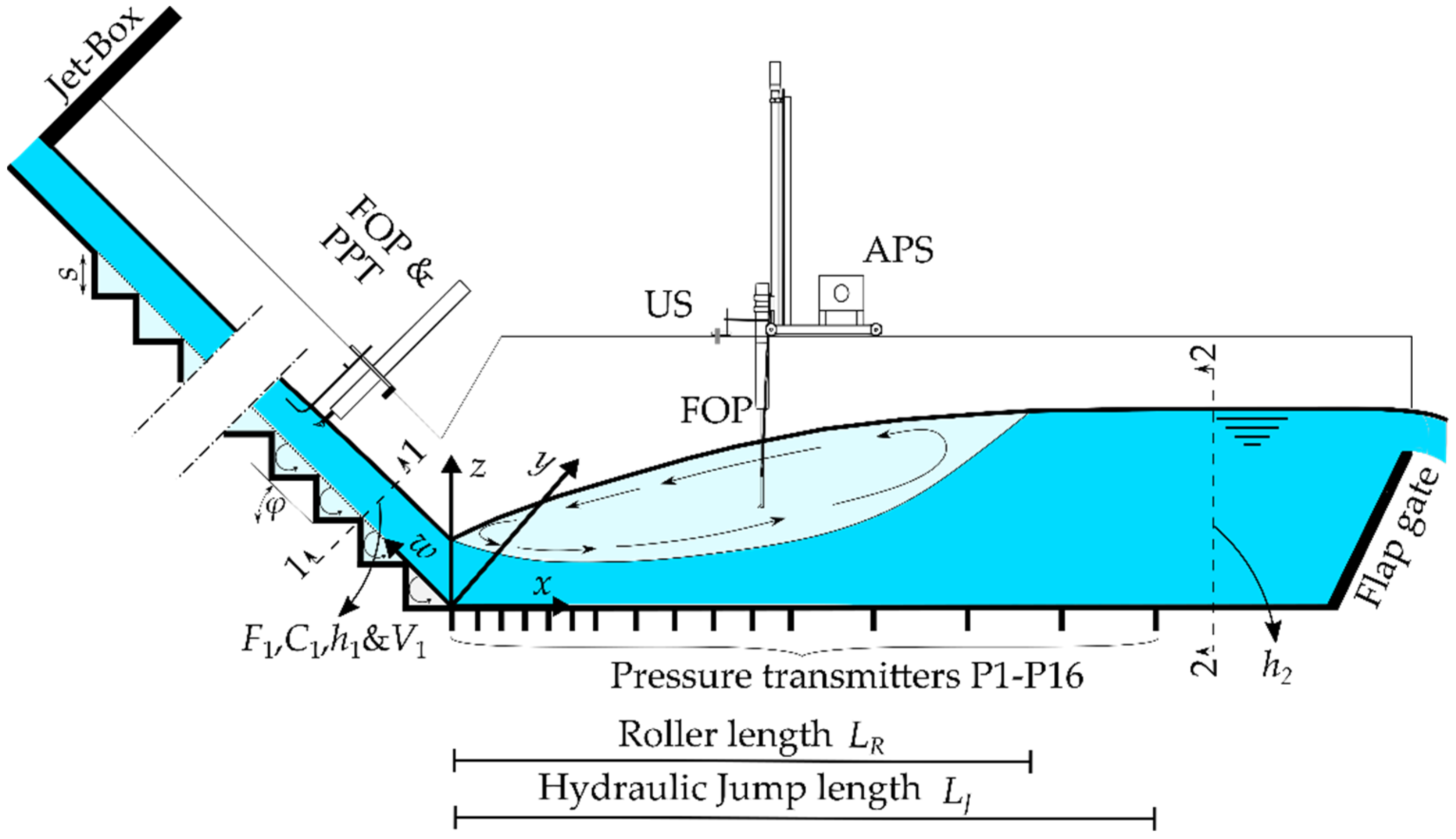

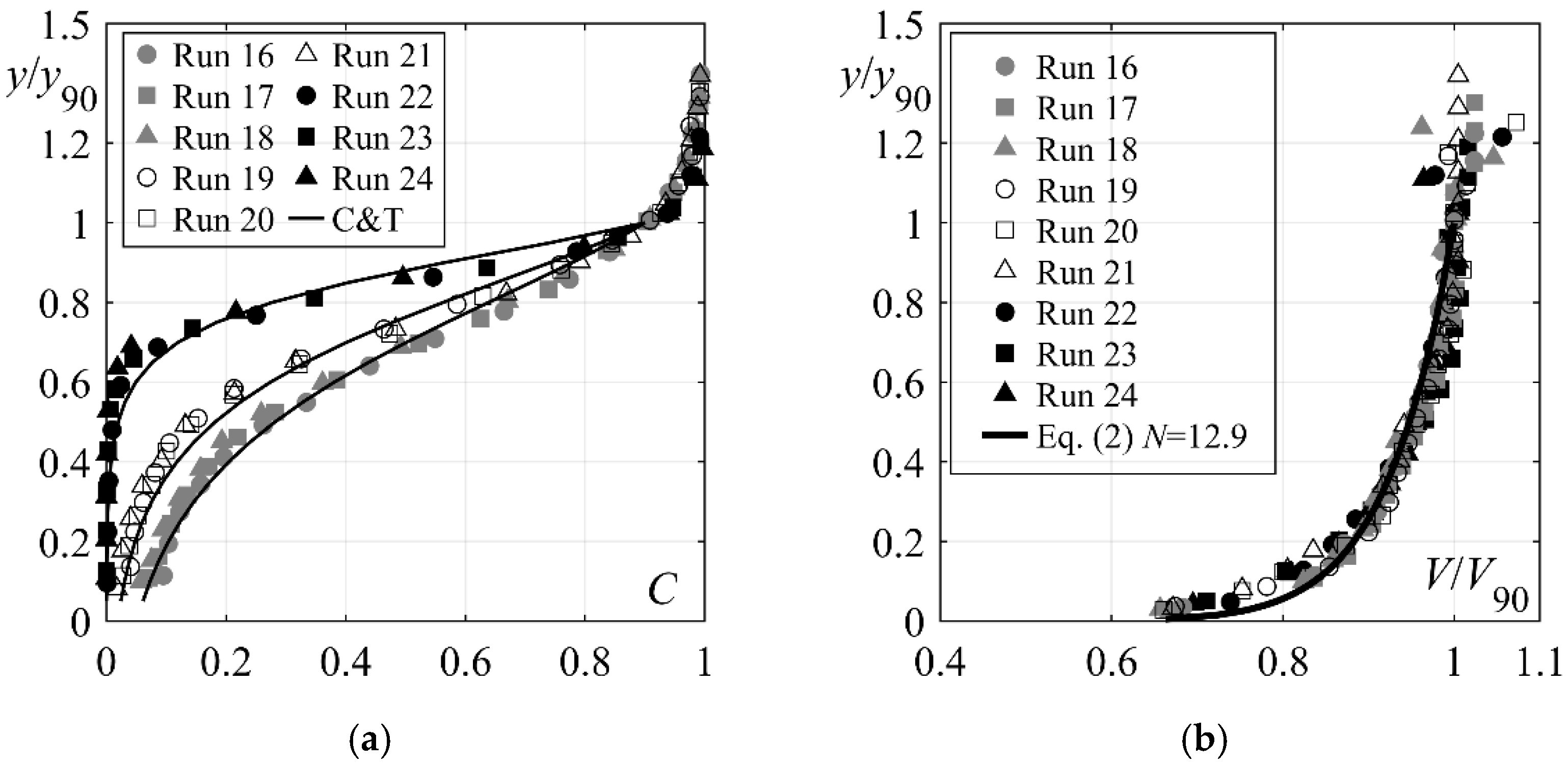
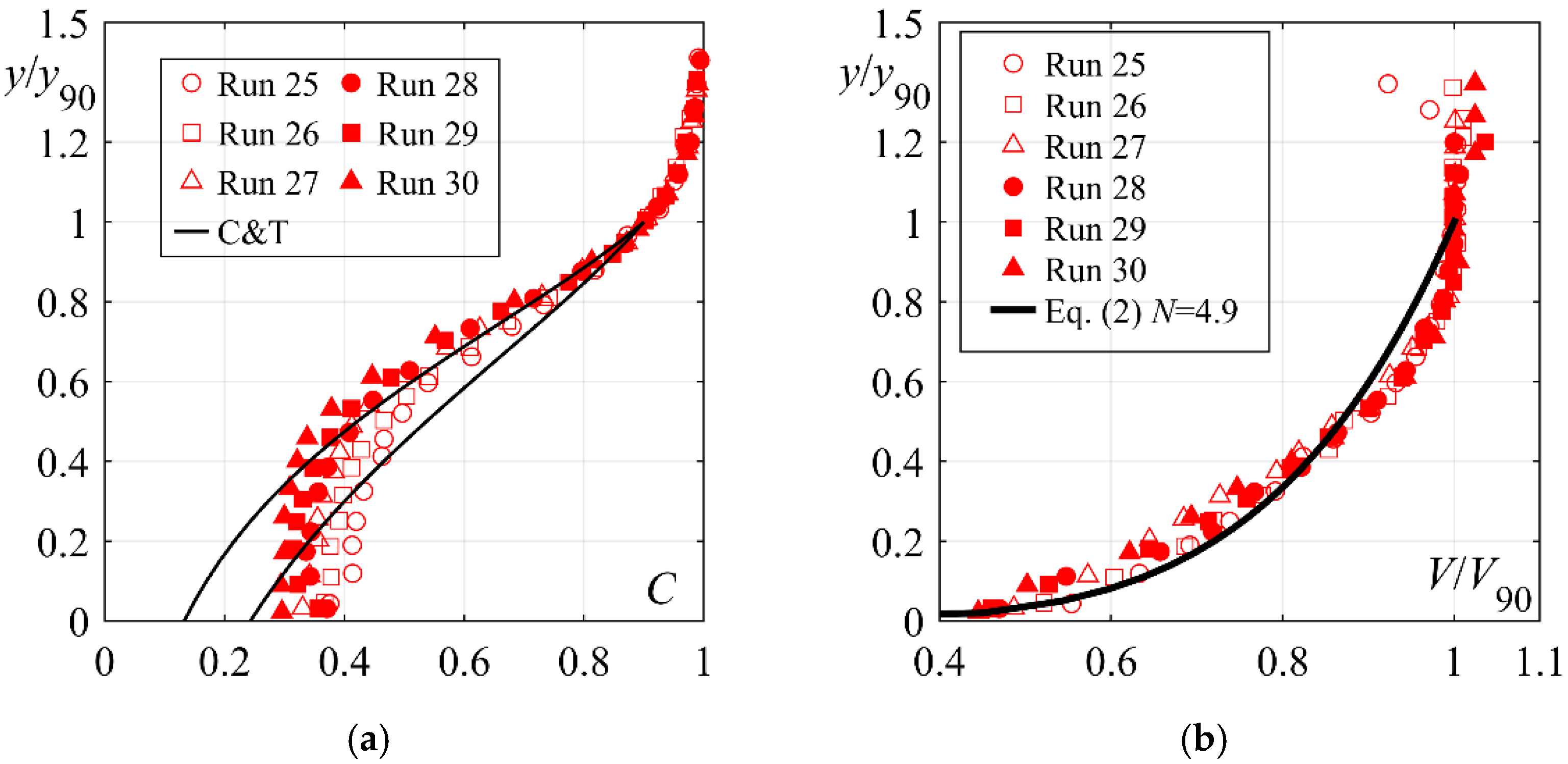
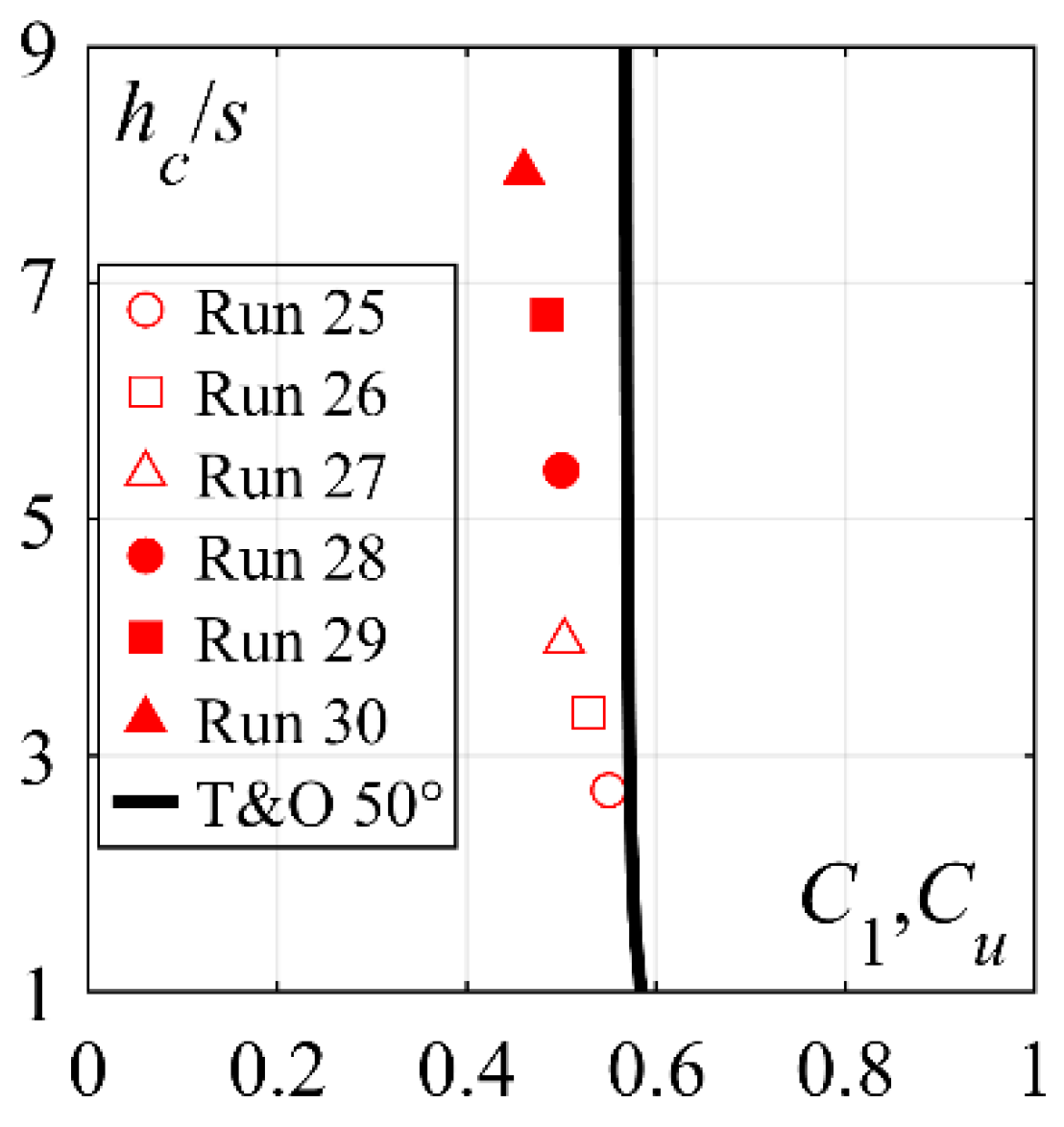

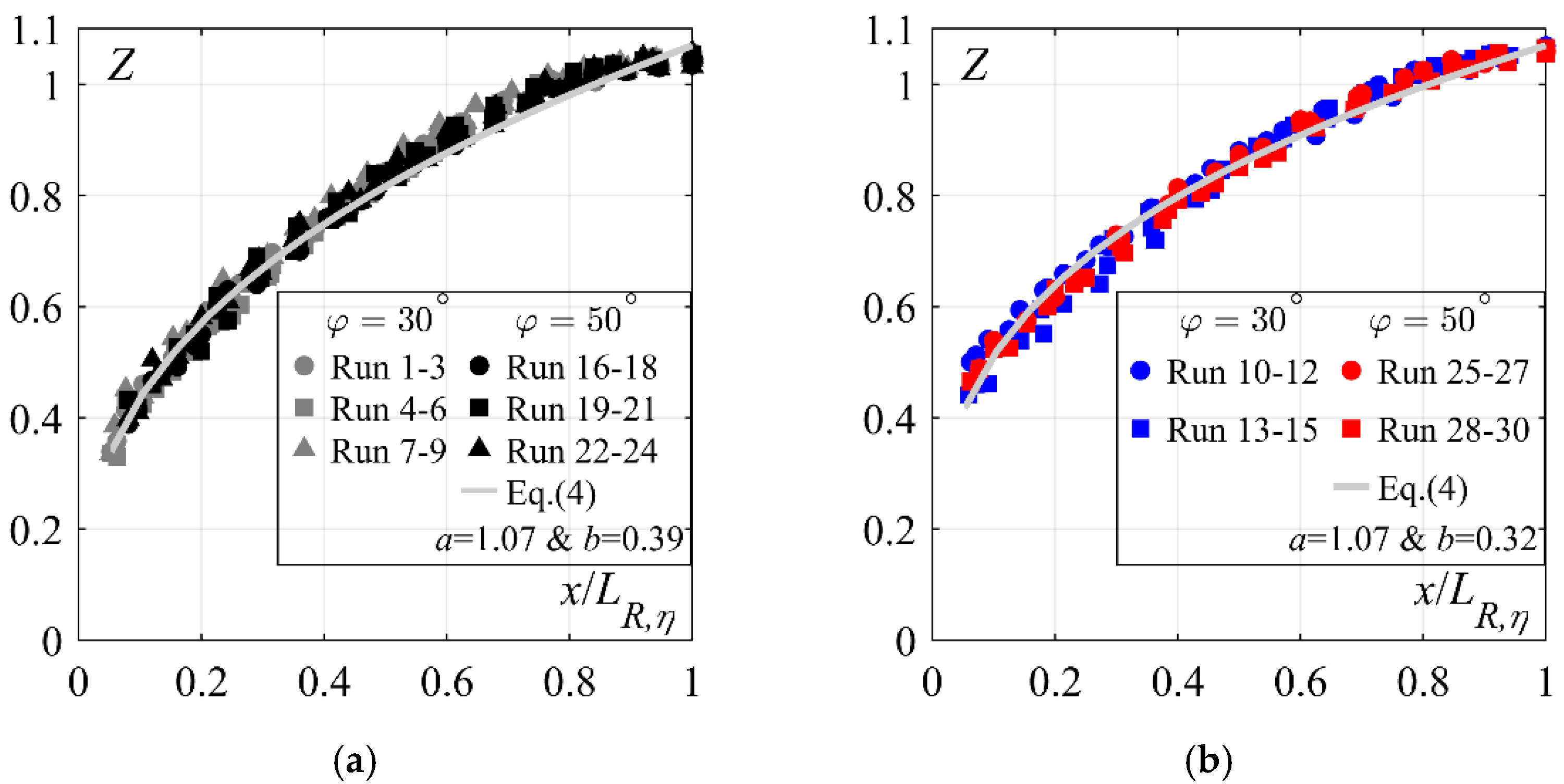
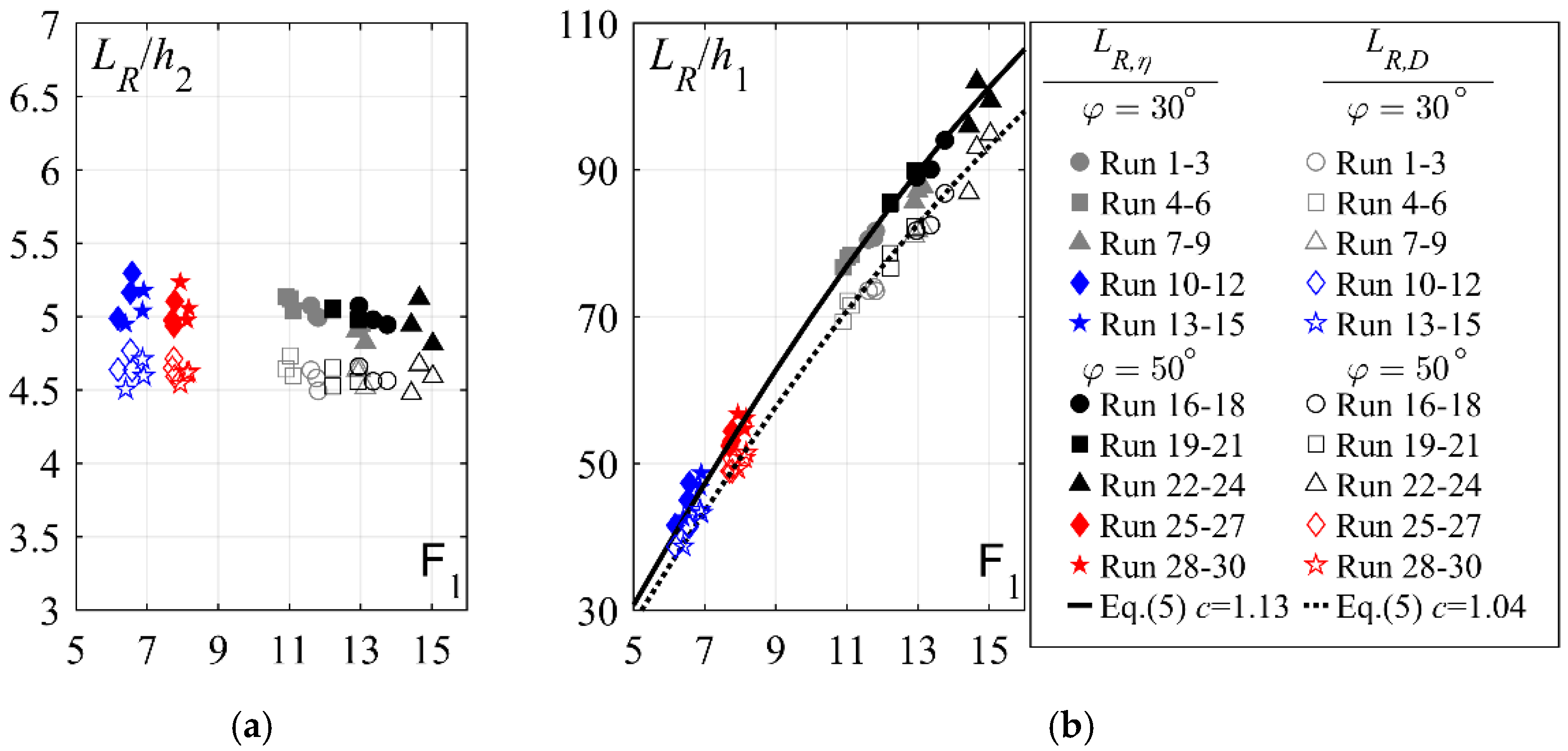
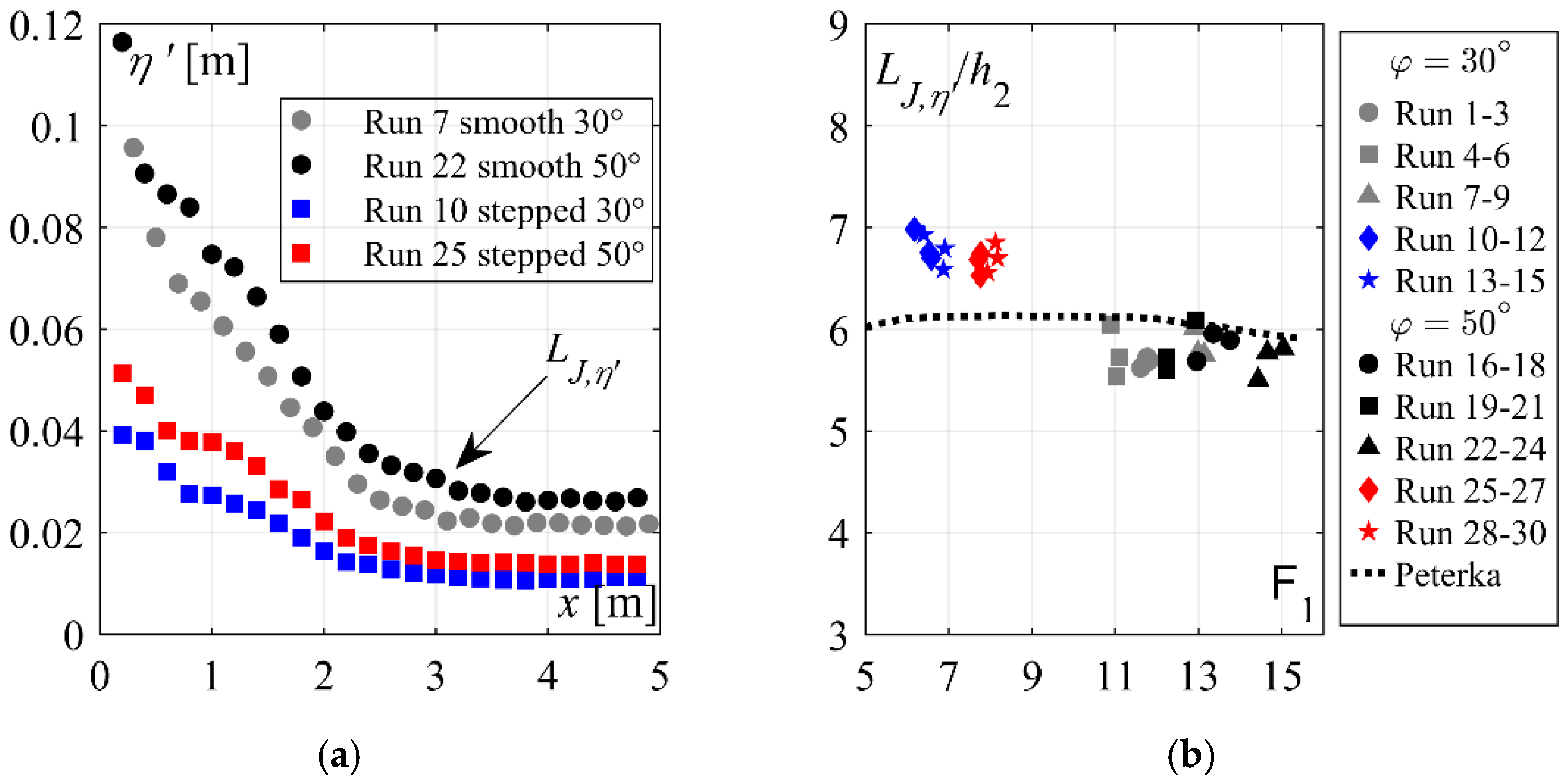
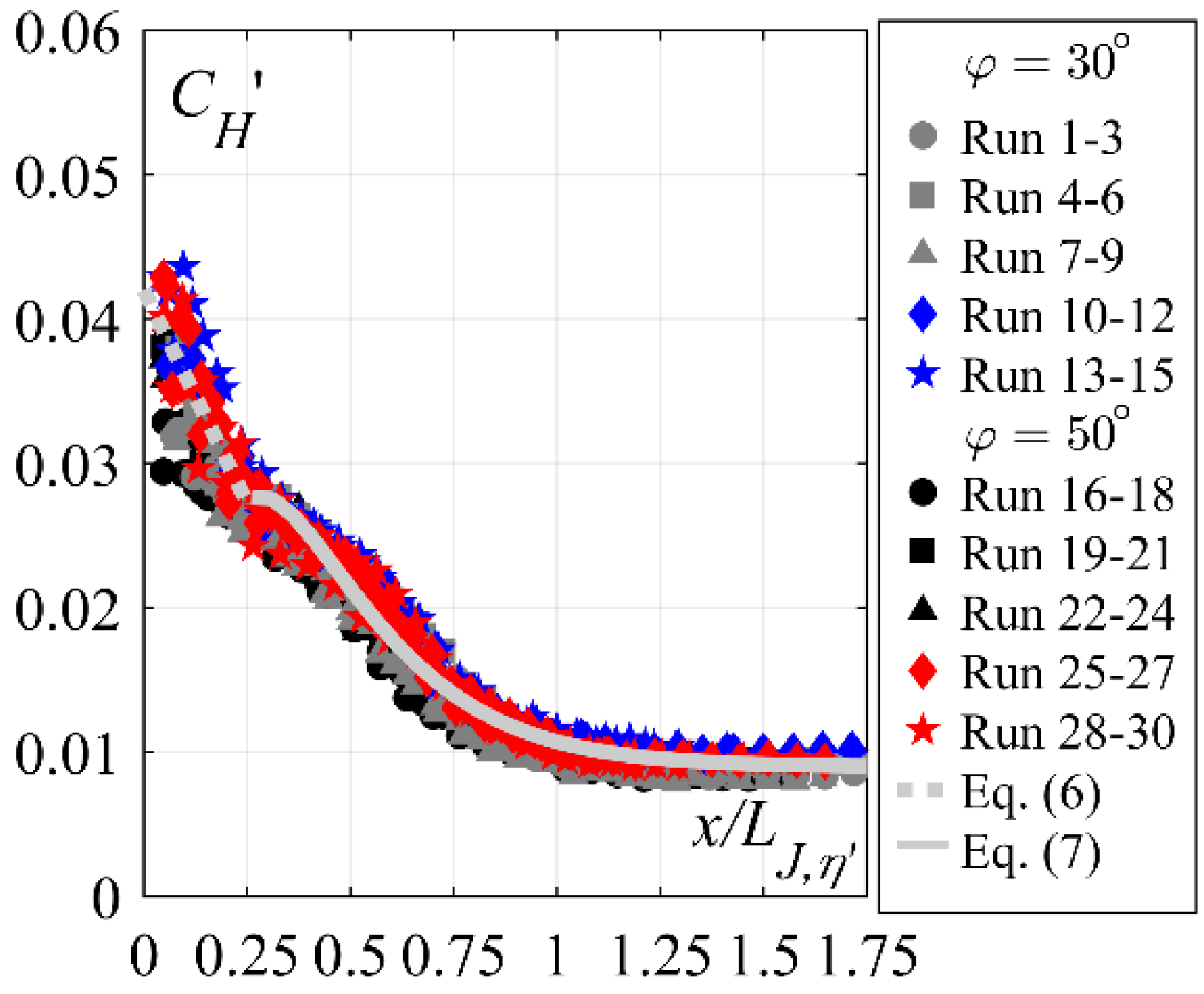
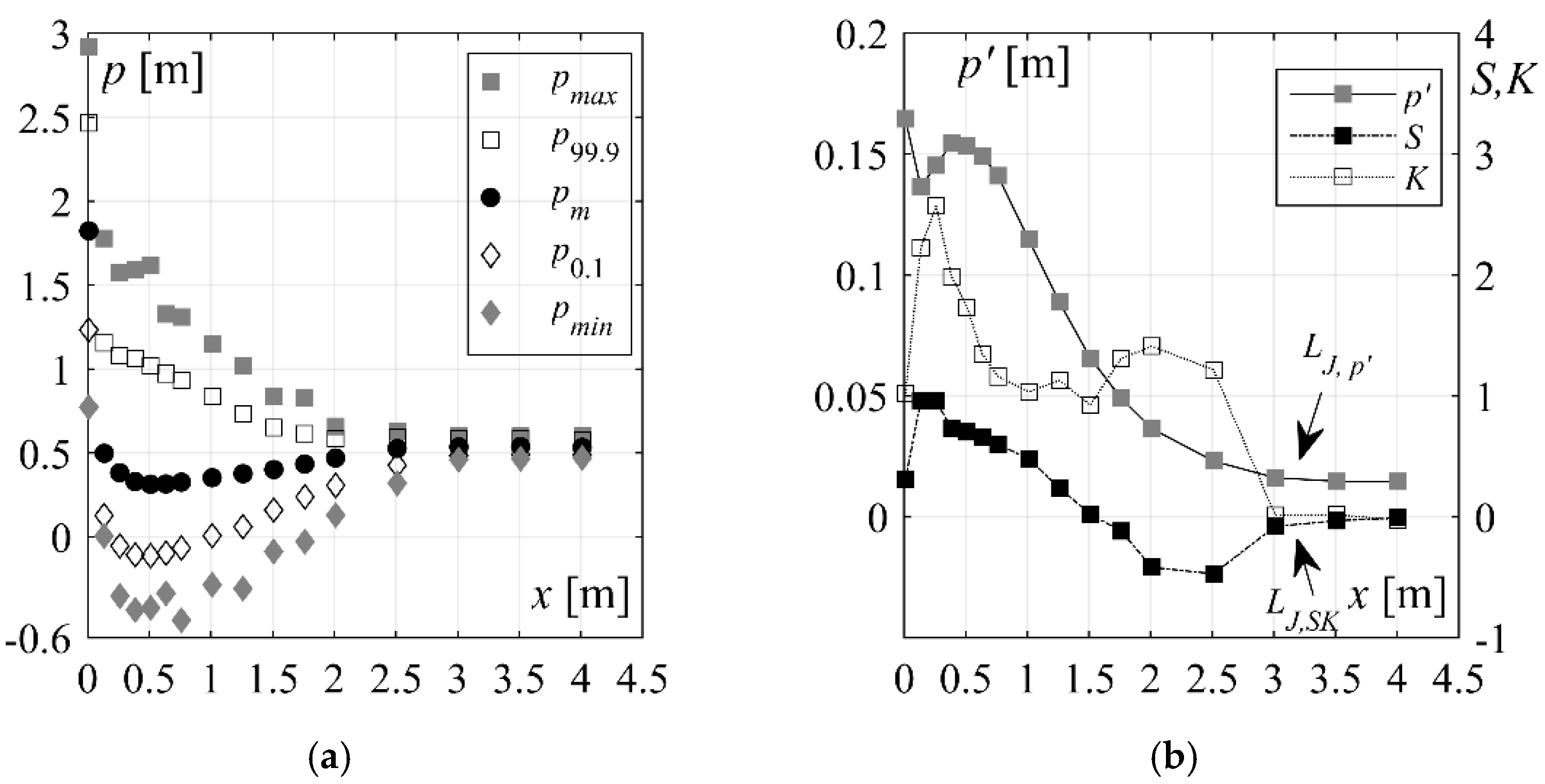
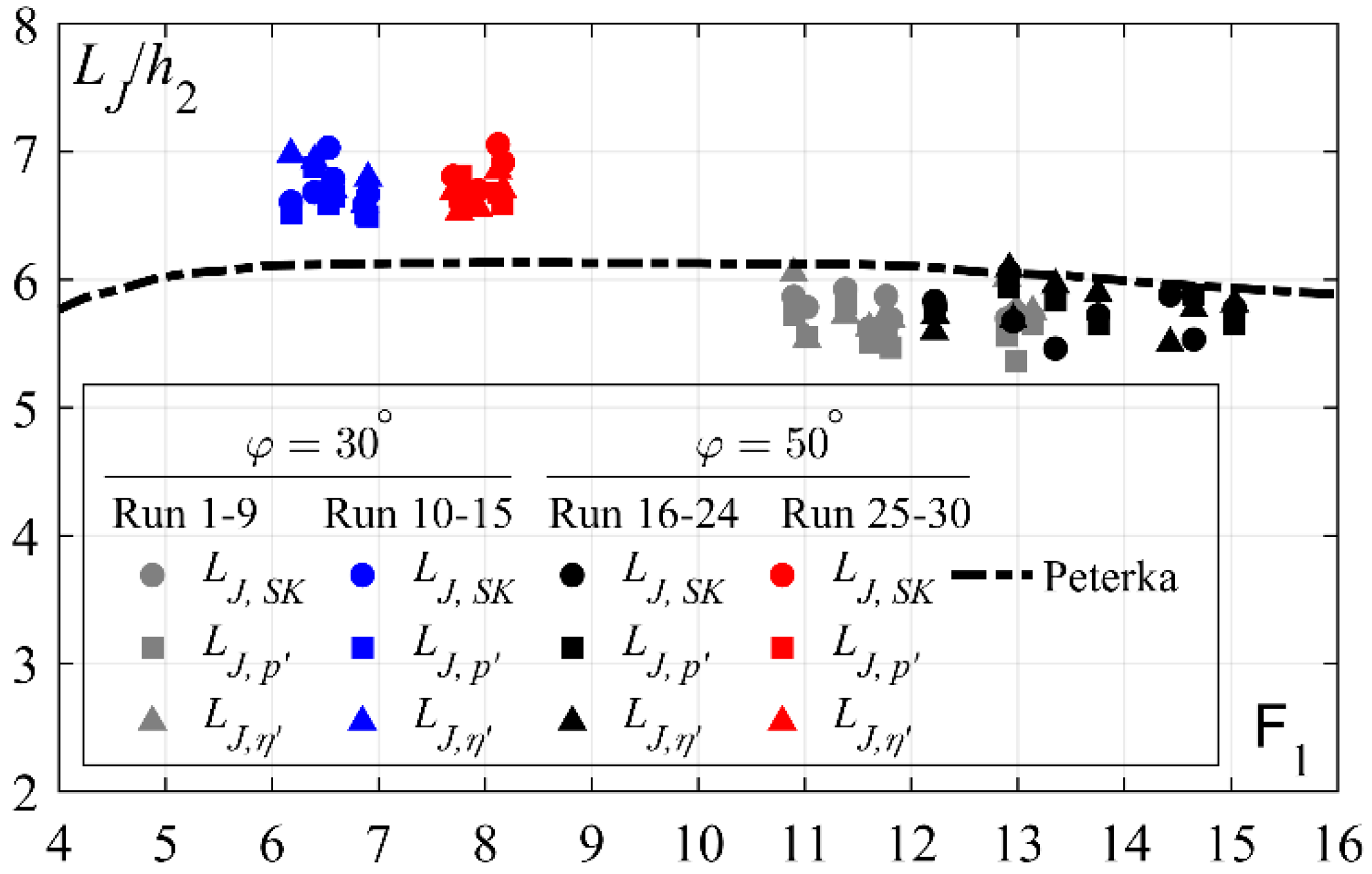
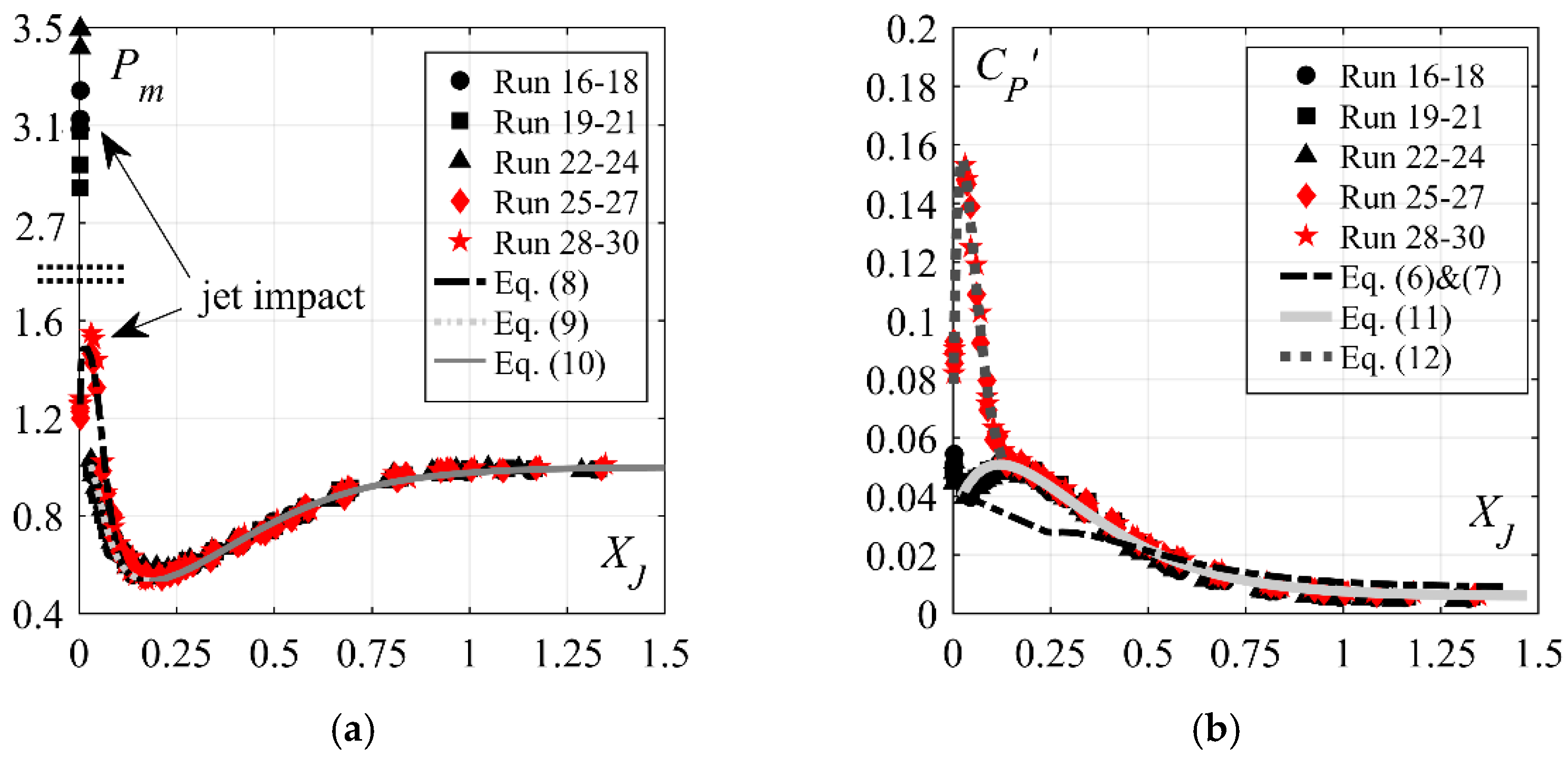
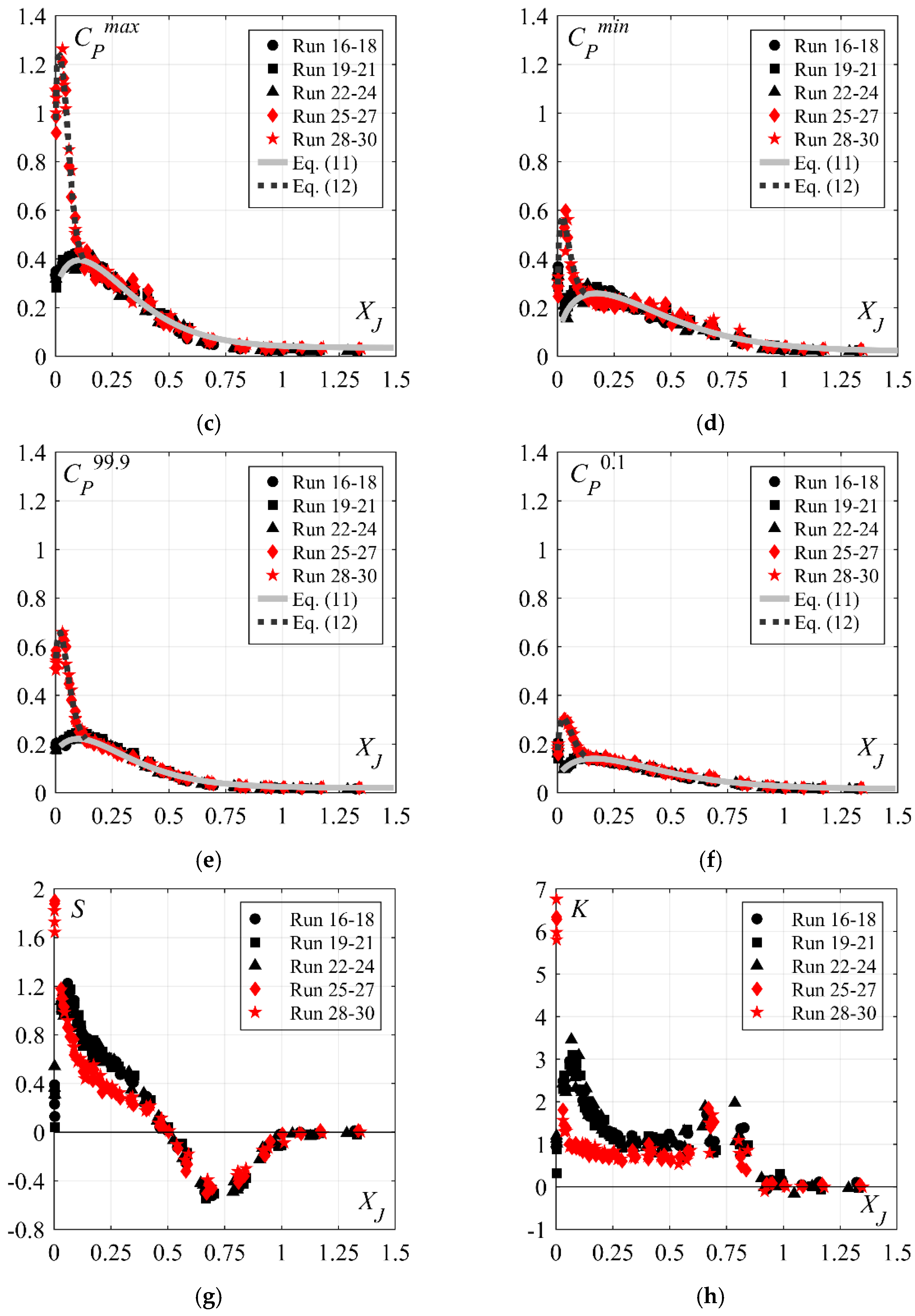
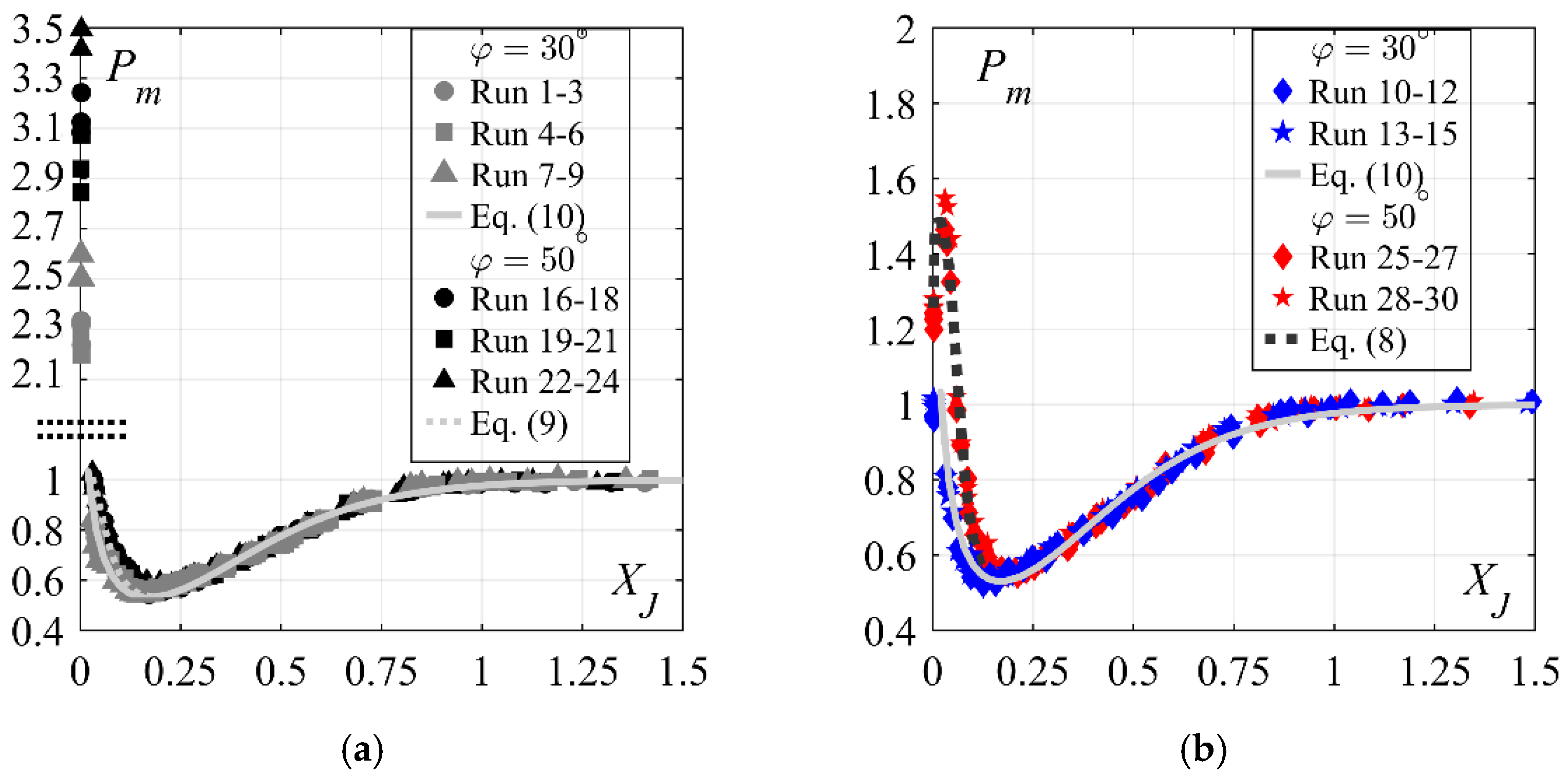
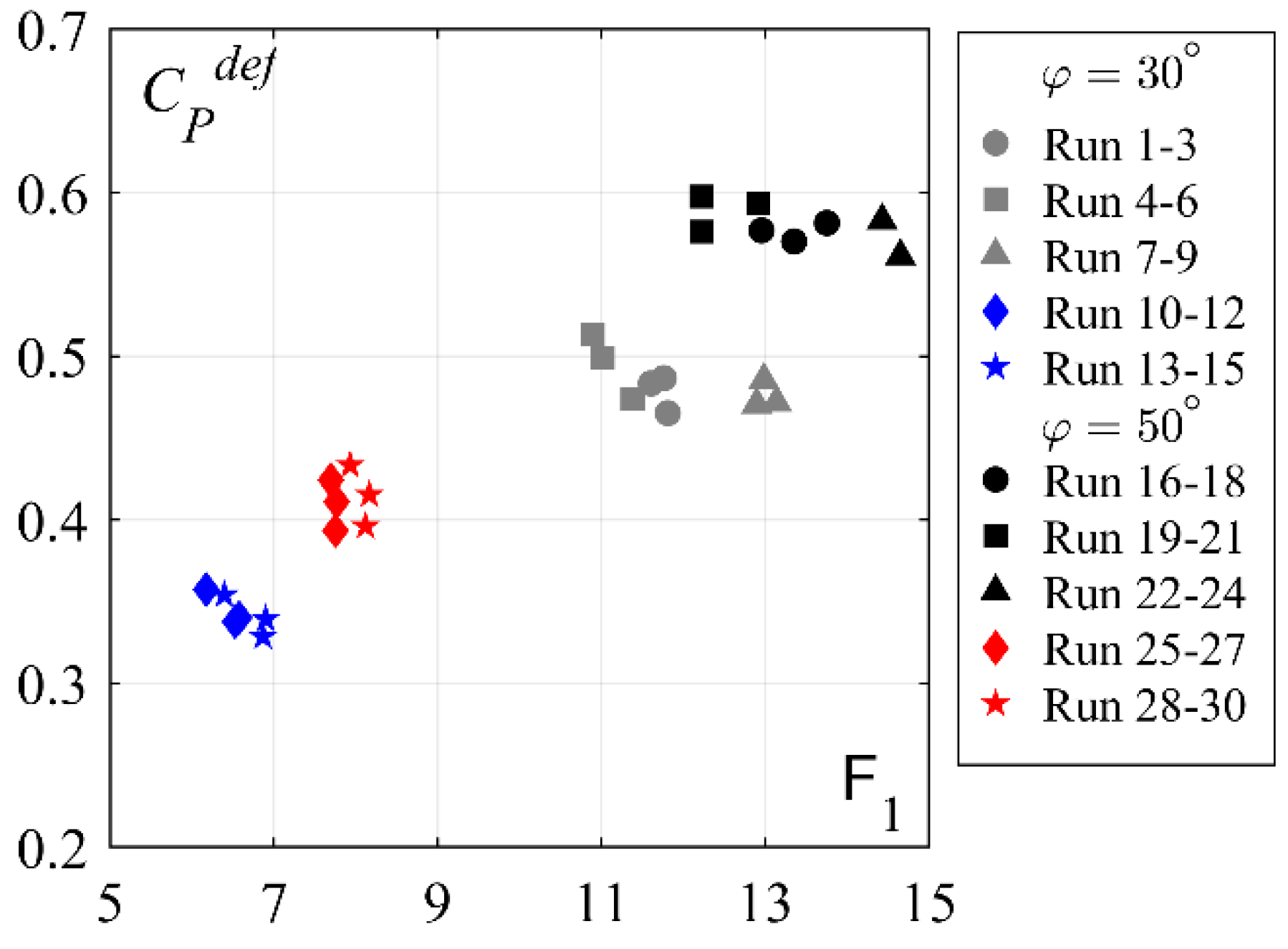
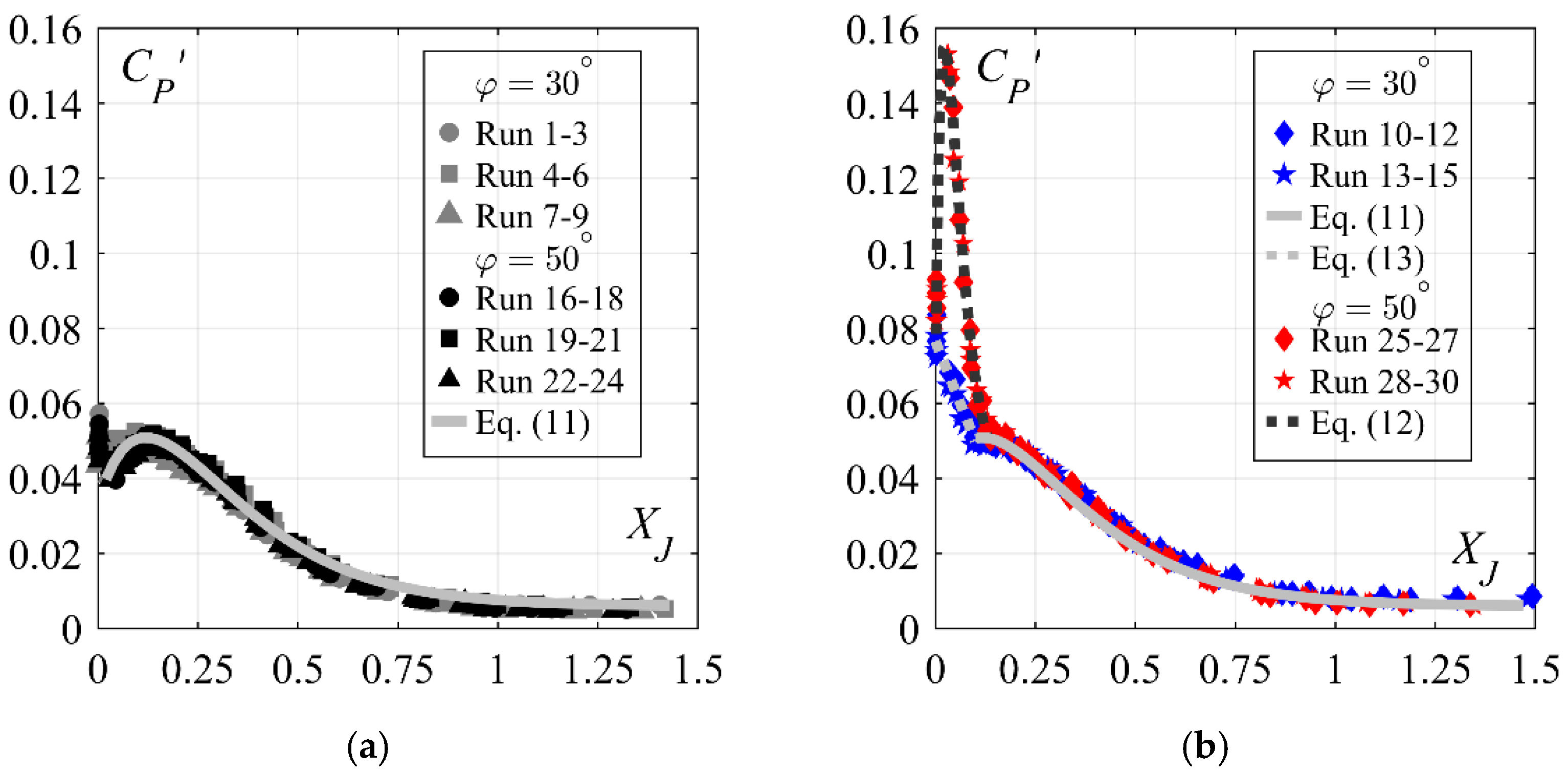
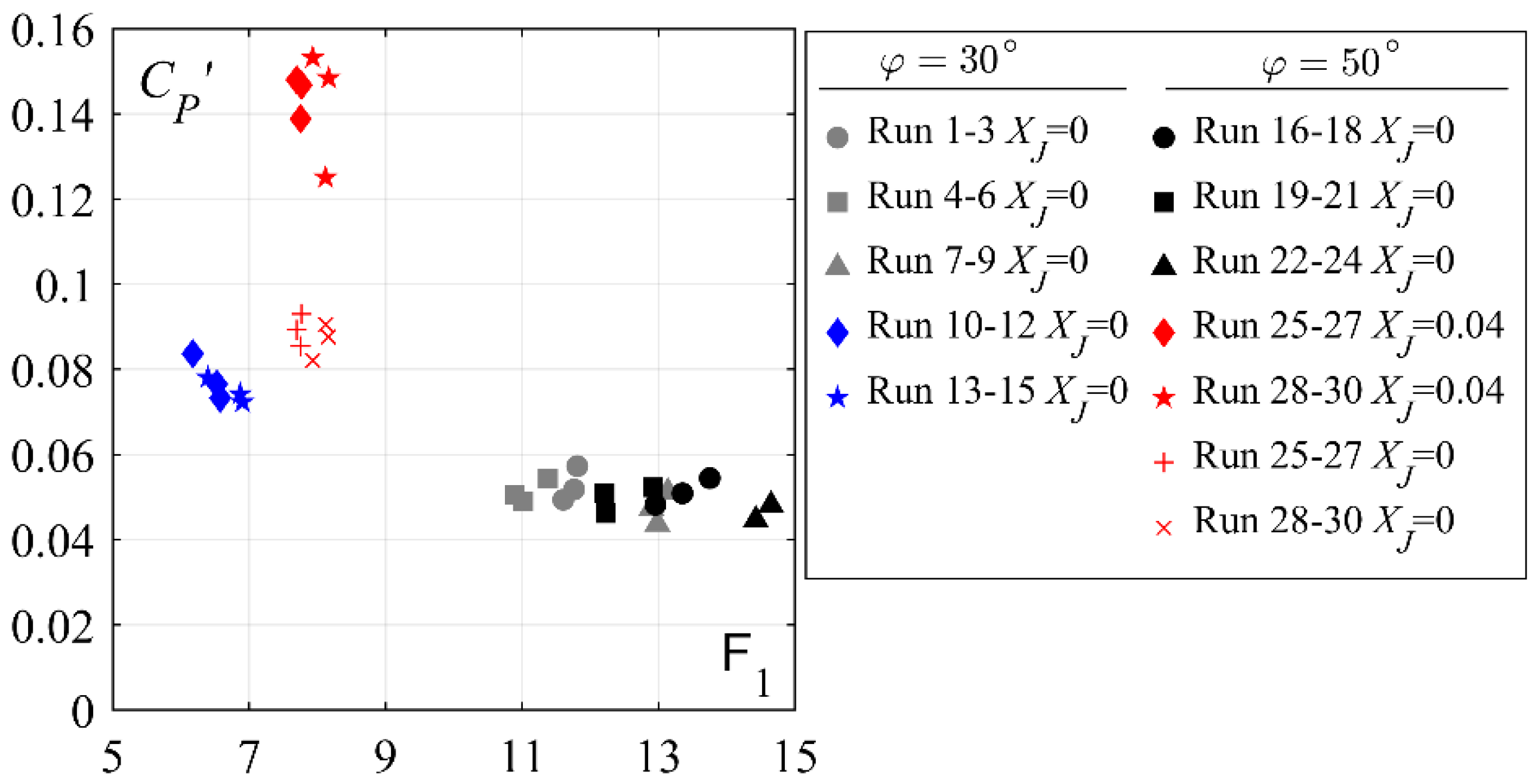
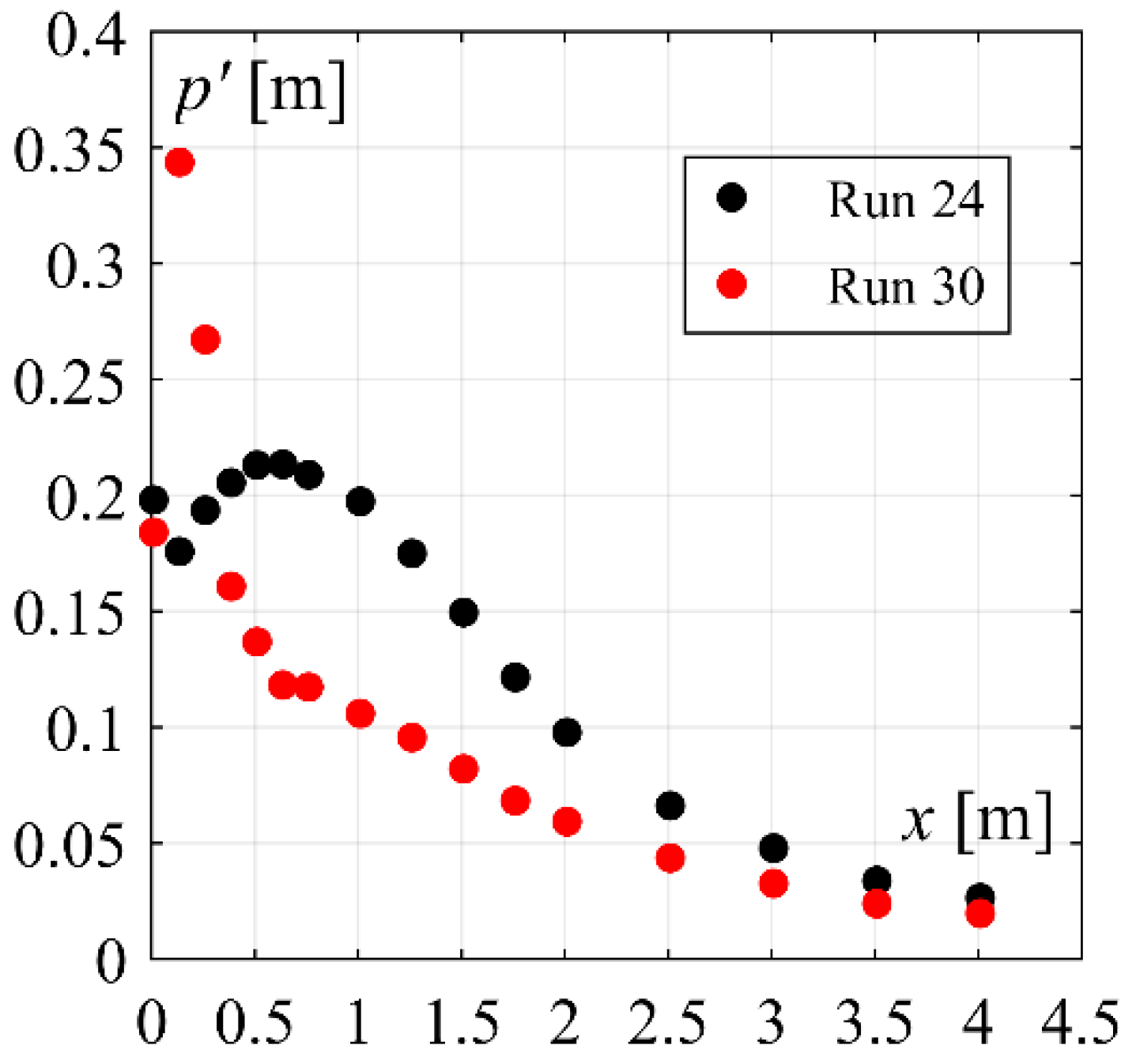
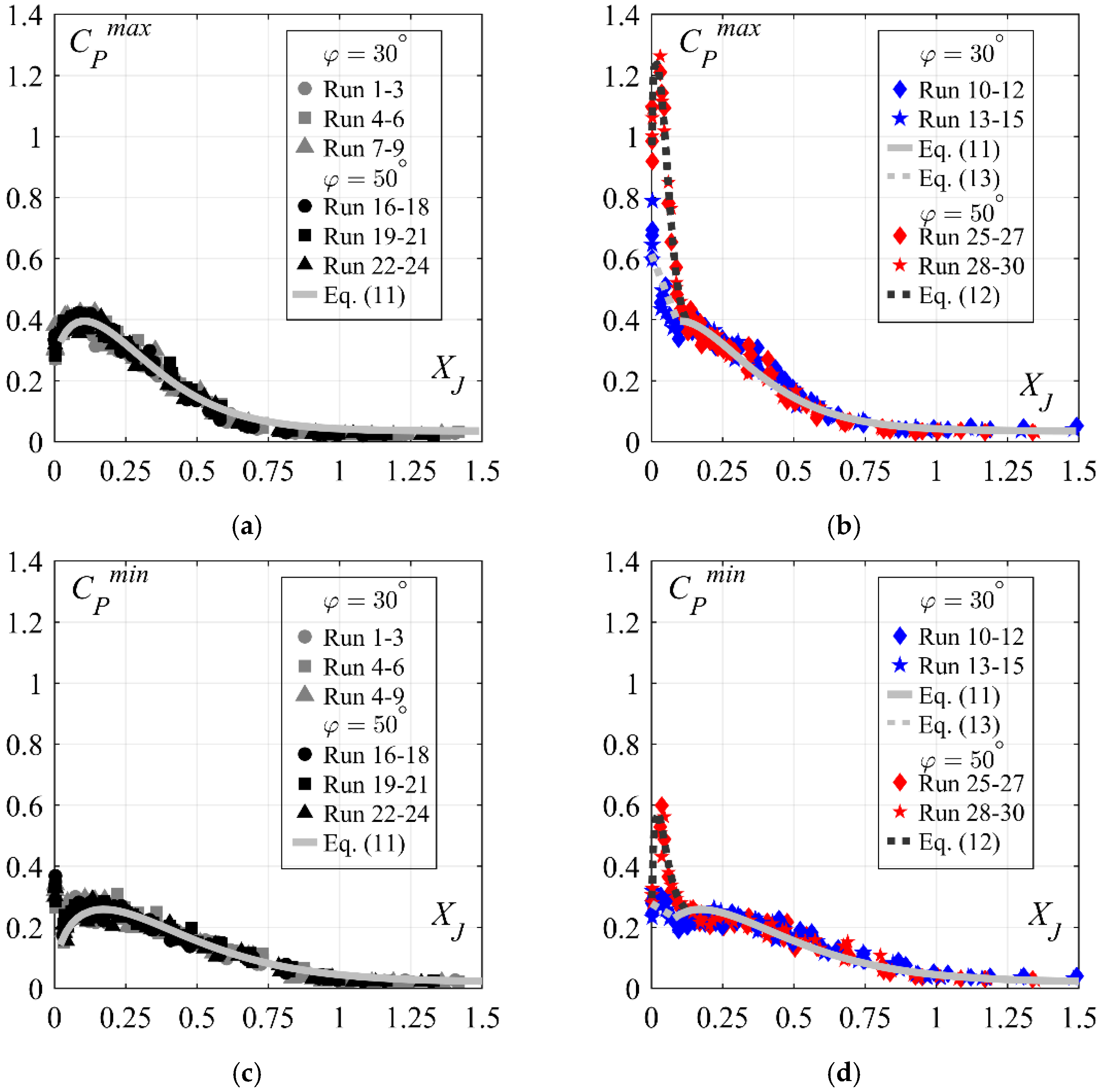

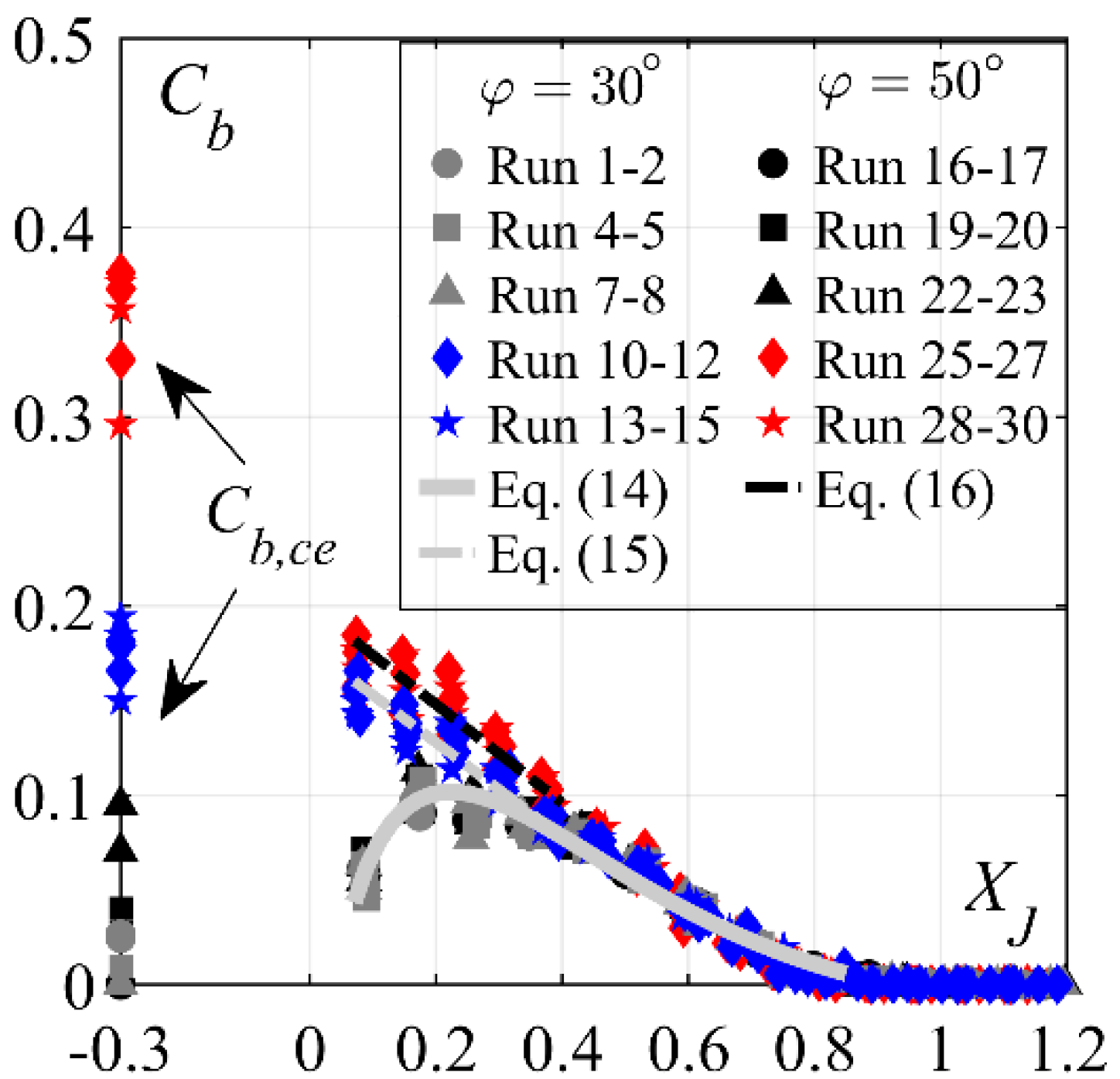
| Chute Configuration | Test Run | φ (°) | q (m2/s) | hc/s (-) | C1 (-) | h1 (m) | V1 (m/s) | α (-) | F1 (-) | R1 × 105 (-) | W1 (-) |
|---|---|---|---|---|---|---|---|---|---|---|---|
| SM + PA | 1 | 30 | 0.198 | / | 0.32 | 0.031 | 6.47 | 1.09 | 11.8 | 1.98 | 133 |
| 2 | 30 | 0.277 | / | 0.32 | 0.038 | 7.22 | 1.08 | 11.8 | 2.77 | 166 | |
| 3 | 30 | 0.358 | / | 0.32 | 0.046 | 7.79 | 1.09 | 11.6 | 3.58 | 196 | |
| SM + R | 4 | 30 | 0.198 | / | 0.25 | 0.032 | 6.21 | 1.09 | 11.1 | 1.98 | 130 |
| 5 | 30 | 0.277 | / | 0.26 | 0.040 | 6.86 | 1.08 | 10.9 | 2.77 | 162 | |
| 6 | 30 | 0.356 | / | 0.26 | 0.047 | 7.51 | 1.08 | 11.0 | 3.56 | 192 | |
| SM | 7 | 30 | 0.198 | / | 0.16 | 0.029 | 6.95 | 1.08 | 13.1 | 1.98 | 137 |
| 8 | 30 | 0.278 | / | 0.15 | 0.036 | 7.68 | 1.08 | 12.9 | 2.78 | 171 | |
| 9 | 30 | 0.356 | / | 0.15 | 0.042 | 6.38 | 1.08 | 13.0 | 3.56 | 202 | |
| ST s = 0.06 m | 10 | 30 | 0.204 | 2.70 | 0.42 | 0.048 | 4.24 | 1.18 | 6.2 | 2.04 | 109 |
| 11 | 30 | 0.284 | 3.36 | 0.42 | 0.058 | 4.91 | 1.18 | 6.5 | 2.84 | 138 | |
| 12 | 30 | 0.362 | 3.95 | 0.41 | 0.068 | 5.35 | 1.18 | 6.6 | 3.62 | 163 | |
| ST s = 0.03 m | 13 | 30 | 0.204 | 5.40 | 0.41 | 0.047 | 4.34 | 1.19 | 6.4 | 2.04 | 110 |
| 14 | 30 | 0.282 | 6.70 | 0.41 | 0.056 | 5.07 | 1.19 | 6.9 | 2.82 | 140 | |
| 15 | 30 | 0.364 | 7.94 | 0.41 | 0.066 | 5.54 | 1.18 | 6.9 | 3.64 | 166 | |
| SM + PA | 16 | 50 | 0.198 | / | 0.37 | 0.028 | 7.16 | 1.08 | 13.8 | 1.98 | 140 |
| 17 | 50 | 0.280 | / | 0.36 | 0.036 | 7.88 | 1.07 | 13.4 | 2.80 | 174 | |
| 18 | 50 | 0.358 | / | 0.35 | 0.043 | 8.38 | 1.07 | 13.0 | 3.58 | 203 | |
| SM + R | 19 | 50 | 0.199 | / | 0.28 | 0.029 | 6.88 | 1.08 | 12.9 | 1.99 | 137 |
| 20 | 50 | 0.278 | / | 0.29 | 0.038 | 7.41 | 1.07 | 12.2 | 2.78 | 168 | |
| 21 | 50 | 0.358 | / | 0.28 | 0.044 | 8.07 | 1.08 | 12.2 | 3.58 | 199 | |
| SM | 22 | 50 | 0.199 | / | 0.16 | 0.026 | 7.61 | 1.08 | 15.0 | 1.99 | 144 |
| 23 | 50 | 0.279 | / | 0.16 | 0.033 | 8.38 | 1.09 | 14.7 | 2.79 | 179 | |
| 24 | 50 | 0.356 | / | 0.15 | 0.040 | 8.99 | 1.08 | 14.4 | 3.56 | 210 | |
| ST s = 0.06 m | 25 | 50 | 0.205 | 2.71 | 0.55 | 0.041 | 4.95 | 1.18 | 7.8 | 2.05 | 118 |
| 26 | 50 | 0.284 | 3.36 | 0.53 | 0.051 | 5.52 | 1.19 | 7.8 | 2.84 | 147 | |
| 27 | 50 | 0.364 | 3.97 | 0.50 | 0.061 | 5.96 | 1.19 | 7.7 | 3.64 | 173 | |
| ST s = 0.03 m | 28 | 50 | 0.205 | 5.51 | 0.50 | 0.040 | 5.10 | 1.18 | 8.1 | 2.05 | 120 |
| 29 | 50 | 0.284 | 6.73 | 0.48 | 0.050 | 5.71 | 1.19 | 8.2 | 2.84 | 149 | |
| 30 | 50 | 0.364 | 7.94 | 0.46 | 0.060 | 6.08 | 1.19 | 7.9 | 3.64 | 174 |
| Equation | Coefficient | CP′ (-) | CPmax (-) | CP99.9 (-) | CPmin (-) | CP0.1 (-) |
|---|---|---|---|---|---|---|
| (11) | d | 1.006 | 1.035 | 1.020 | 1.020 | 1.015 |
| e | 3.00 | 3.41 | 3.31 | 2.52 | 2.46 | |
| f | 0.31 | 3.41 | 1.60 | 1.80 | 0.79 | |
| j | 0.006 | 0.060 | 0.037 | 0.010 | 0.010 | |
| R2 | 0.99 | 0.97 | 0.98 | 0.91 | 0.97 | |
| (12) | k | 1.04 | 1.36 | 1.19 | 1.24 | 1.12 |
| l | 19 | 28 | 21 | 24 | 18 | |
| m | 6 | 154 | 31 | 28 | 10 | |
| n | 0.000 | 0.020 | 0.070 | −0.050 | −0.007 | |
| R2 | 0.98 | 0.96 | 0.97 | 0.86 | 0.96 | |
| (13) | o | −0.266 | −2.400 | −1.650 | −0.560 | −0.375 |
| r | 0.076 | 0.604 | 0.362 | 0.278 | 0.175 | |
| R2 | 0.90 | 0.75 | 0.90 | 0.42 | 0.60 |
Publisher’s Note: MDPI stays neutral with regard to jurisdictional claims in published maps and institutional affiliations. |
© 2022 by the authors. Licensee MDPI, Basel, Switzerland. This article is an open access article distributed under the terms and conditions of the Creative Commons Attribution (CC BY) license (https://creativecommons.org/licenses/by/4.0/).
Share and Cite
Stojnic, I.; Pfister, M.; Matos, J.; Schleiss, A.J. Plain Stilling Basin Performance below 30° and 50° Inclined Smooth and Stepped Chutes. Water 2022, 14, 3976. https://doi.org/10.3390/w14233976
Stojnic I, Pfister M, Matos J, Schleiss AJ. Plain Stilling Basin Performance below 30° and 50° Inclined Smooth and Stepped Chutes. Water. 2022; 14(23):3976. https://doi.org/10.3390/w14233976
Chicago/Turabian StyleStojnic, Ivan, Michael Pfister, Jorge Matos, and Anton J. Schleiss. 2022. "Plain Stilling Basin Performance below 30° and 50° Inclined Smooth and Stepped Chutes" Water 14, no. 23: 3976. https://doi.org/10.3390/w14233976
APA StyleStojnic, I., Pfister, M., Matos, J., & Schleiss, A. J. (2022). Plain Stilling Basin Performance below 30° and 50° Inclined Smooth and Stepped Chutes. Water, 14(23), 3976. https://doi.org/10.3390/w14233976








